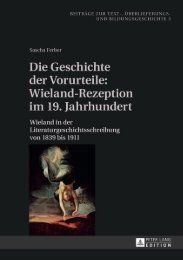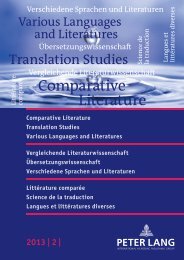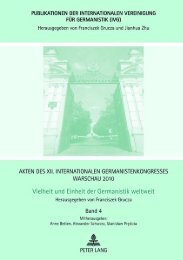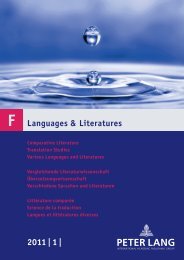Extract (PDF) - Peter Lang
Extract (PDF) - Peter Lang
Extract (PDF) - Peter Lang
You also want an ePaper? Increase the reach of your titles
YUMPU automatically turns print PDFs into web optimized ePapers that Google loves.
24 Fernanda Peñaloza<br />
of Patagonia. Indeed, we would like to highlight the fact that while this<br />
volume discusses texts from different periods and attempts to historicise<br />
and analyse discursive operations from a wide range of perspectives, it does<br />
not however make any attempt at “coverage”. Within the extensive choice<br />
of narratives that could serve the purpose of exploring the representation<br />
of Patagonia well, the authors have opted for a reading of specific texts<br />
that trace different experiences that relate to the region: a shipwreck in<br />
1741 (Hulme), the friendship of Darwin and FitzRoy (Schell), Dixie’s trip<br />
to Patagonia as reworked in her children’s stories (Mackintosh), Bridge’s<br />
missionary enterprise (Peñaloza), the Welsh Diaspora (Birt), the Argentine<br />
colonisation of Patagonia (Andermann), the fear of the Patagonian silence<br />
in Darwin, Hudson, Moreno and Meyer (Wilson); Chatwin’s literary<br />
pilgrimages (Posso) and Aira’s interpretation of the expansion of the frontier<br />
( Jagoe). The different themes on which the essays focus are illustrative<br />
of the diversity characterising the representation of this region, and it does<br />
therefore undermine any impression of a unified body of texts reflecting<br />
all realms experience. However, this volume aims at making a contribution<br />
to the significant advancement of innovative studies that take as their<br />
field of enquiry the historical circumstances of exploration and colonisation<br />
of Patagonia, and the cultural, political and economic outcomes<br />
of these processes.30 The most recent and accomplished example of this<br />
line of research is the historical work of Susana López in Representaciones<br />
de la Patagonia: Colonos, Científicos y Políticos (1870–1914).31 From a different<br />
approach, Ernesto Livon-Grosman’s Geografías Imaginarias32 is<br />
30 However, narratives of travel and exploration on Patagonia have received little<br />
academic coverage in English. Scholarly work is limited to a handful of journal<br />
articles such as Joy Longan, “Discovering the ‘Real’: Travels in Patagonia”, Romance<br />
Studies 21 (1993): 63–70; Gabriela Nouzeilles’s “Patagonia as a Borderland: Nature,<br />
Culture, and the Idea of the State”, Journal of Latin American Cultural Studies. 8.1<br />
(1999): 35–48; and Eva-Lynn Alicia Jagoe, “Patagonian Peripheries”, Studies in Travel<br />
Writing 7.1 (2003): 29–45. See also, Gabriela Nouzeilles, “Desert Dreams: Nomadic<br />
Tourists and Cultural Discontent”, trans. Jens Andermann, in Jens Andermann and<br />
William Rowe, eds, Images of Powe: Iconography, Culture and the State in Latin<br />
America. Berghahn Books: New York & Oxford, 2005.<br />
31 La Plata: Ediciones al Margen, 2003.<br />
32 Rosario: Beatriz Viterbo Editora, 2003.

















